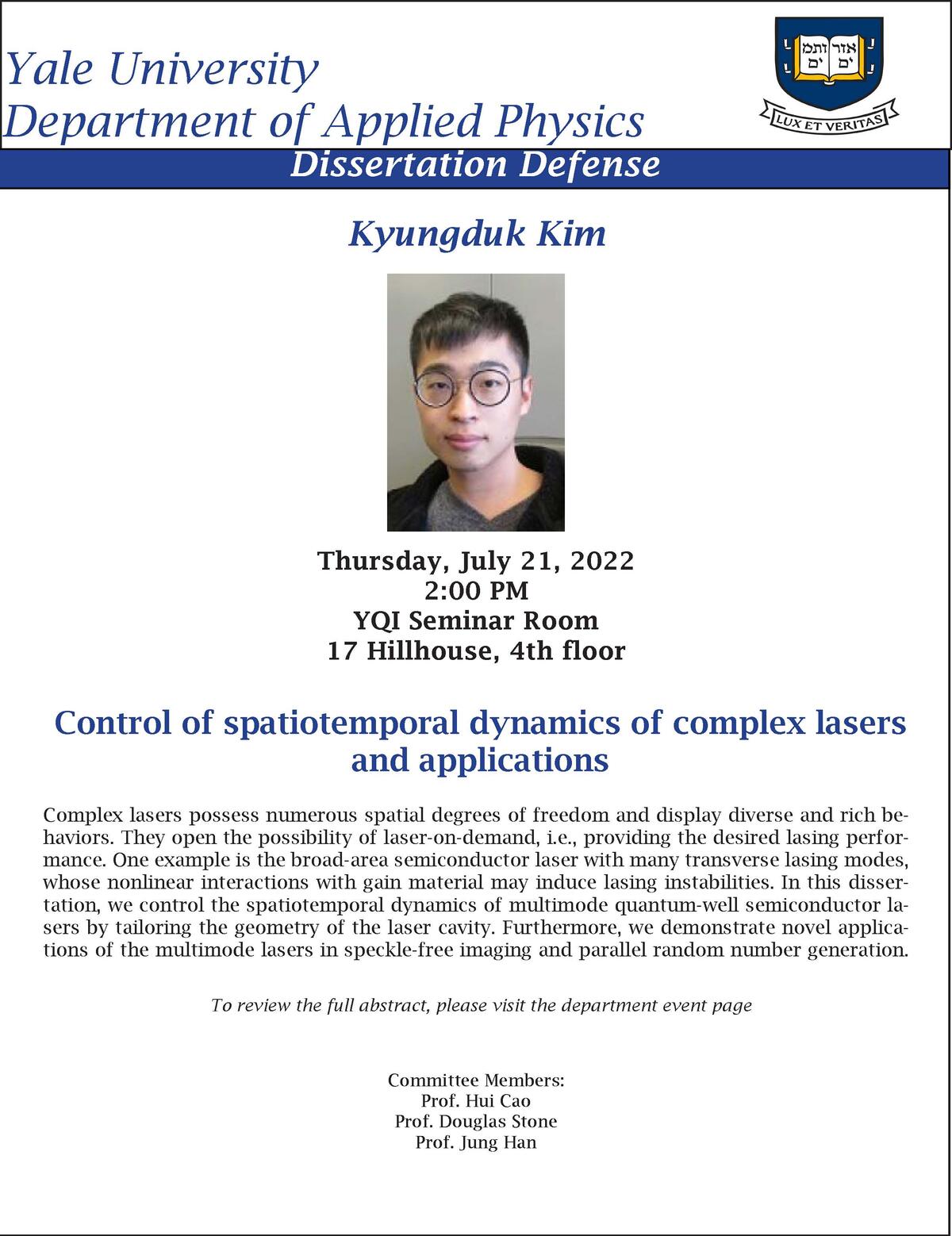Department of Applied Physics
Dissertation Defense - Kyungduk Kim
Thursday, July 21st at 2:00PM
YQI Seminar Room
or via Zoom
Control of spatiotemporal dynamics of complex lasers and applications
Complex lasers possess numerous spatial degrees of freedom and display diverse and rich behaviors. They open the possibility of laser-on-demand, i.e., providing the desired lasing performance. One example is the broad-area semiconductor laser with many transverse lasing modes, whose nonlinear interactions with gain material may induce lasing instabilities. In this dissertation, we control the spatiotemporal dynamics of multimode quantum-well semiconductor lasers by tailoring the geometry of the laser cavity. Furthermore, we demonstrate novel applications of the multimode lasers in speckle-free imaging and parallel random number generation.
First, we investigate the impact of asymmetric cavity geometries—from integrable to chaotic—on the spatiotemporal instabilities in broad-area edge-emitting semiconductor lasers. We aim to understand how the spatial structure of the lasing modes affects the nonlinear light-matter interactions and the mode competition for gain. This, in turn, allows understanding of the role of classical ray dynamics, which dictates the wavefunction of the passive cavity resonances. We experimentally show that the cavity shape profoundly affects the laser fluctuation power and the spatiotemporal scales of the instabilities. It will eventually enable us to engineer the lasing dynamics by designing the cavity shape based on ray dynamical principles. Moreover, our method of manipulating nonlinear dynamics will have an impact on controlling not only semiconductor lasers but also other complex systems with spatiotemporal instabilities.
Secondly, we design, fabricate, and characterize novel semiconductor lasers as illumination sources for high-speed speckle-free imaging. To obtain directional emission, we focus on the stable cavity configuration. By optimizing the cavity shape, we experimentally demonstrate hundreds of transverse lasing modes in a single microcavity, with a decoherence time as short as a few nanoseconds. Furthermore, we show that a small perturbation from the planar cavity—a bifurcation point of classical ray dynamics—can dramatically modify the lasing behavior. Even with slightly curved end facets, our near-planar cavity laser features significantly reduced lasing instabilities. The unique combination of high power, low spatial coherence, short decoherence time, and directional emission will make our laser an excellent light source for speckle-free full-field imaging and parallel display.
Finally, we invent a new physical random number generator based on our many-mode semiconductor laser. By tailoring the cavity geometry, we eliminate the long-range correlations in the emission intensity and process the complex interference pattern of numerous lasing modes in space and time for parallel random bit generation. We demonstrate the ultrafast generation of hundreds of independent random bit streams in parallel from a single chip-scale laser. We accelerate the total bit generation rate to 250 Terabits per second, which exceeds the state-of-the-art physical random bit generators with offline post-processing by two orders of magnitude. Our scalable, robust, and energy-efficient approach will pave the way for secure communications and high-performance computing.
Committee Members:
Prof. Hui Cao
Prof. Douglas Stone
Prof. Jung Han
